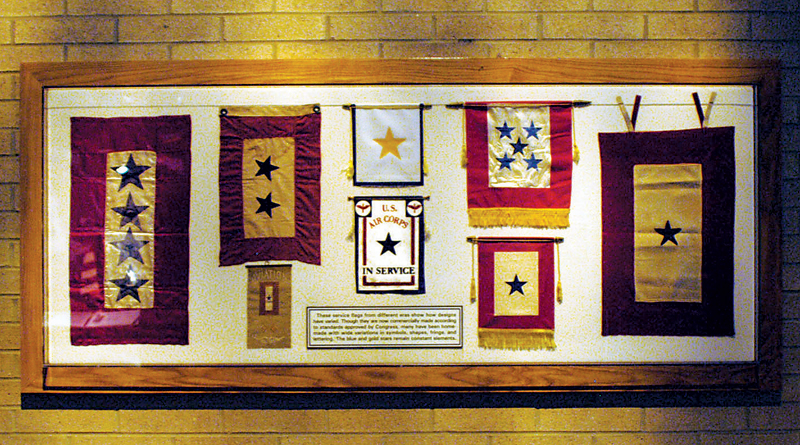Military Star Banners & Gold Star Families ~ The History of Ordinary Things

A service flag or banner is one that family members of those serving in the U.S. Armed Forces can display. It is officially defined as a white field with a red border, with a blue star for each immediate family member serving during any period of war or conflict. According to the Dept of Defense code, the flag size ratio must be 10:19, the same as the American flag.
The service flag was designed and patented by World War I Captain Robert L. Queissner whose two sons were serving on the front line. The flag was intended to be displayed in the front window of peoples’ homes, to indicate one or more family members were in the Armed Services.
In 1918, President Woodrow Wilson approved a request from the Women’s Committee of the Council of National Defense that American women who had lost a child serving in the war should wear a black mourning band on the left arm with a gilt star for each child lost. This approval led to the tradition of a gold star covering the blue star on the banner to show that the service member had passed. The Gold Star represented valor and sacrifice to the cause of freedom. (It is believed Wilson coined the term “Gold Star Mother”.)
Soon after World War I, the Gold Star Mother’s Club was formed by Grace Darling Siebold (son, Lieut. George Vaughn Seibold) to support other mothers who had lost children in the war. The club’s other purpose was to give loving care/visits to hospitalized veterans confined in government hospitals far from home.
American Gold Star Mothers, Inc. was founded in 1929 as a non-denominational, non-profit, and non-political organization. Twenty-five mothers living in Washington, D.C., were original members of the group. Other clubs across the nation quickly requested membership. Still active today, there are over 900 members.
In 1936, the United States began recognizing mothers of fallen service members by observing Gold Star Mother’s Day on the last Sunday of September. Amended in 2011, President Barack Obama made this commemorative day Gold Star Mother’s and Family’s Day.
Of those who serve in the U.S. military, 1 in 10 suffer a severe injury, the majority combat related. May 1st has been designated as Silver Star Service Day to honor the sacrifices of combat wounded, ill, and dying service members.
The use of service flags and wearing of gold star pins (issued by the Defense Department) has declined, but their meaning as symbols of sacrifice remains significant and relevant yet today.
In a proclamation issued in 2015, Obama said that most Americans cannot fully comprehend the price Gold Star family members have paid: “Their sleepless nights allow for our peaceful rest, and the folded flags they hold dear are what enable ours to wave. The depth of their sorrow is immeasurable, and we are forever indebted to them for all they have given us.”
Doris is a collector, a storyteller and a free-lance curator whose passion is unlocking the stories in collections from family or private individuals. She develops and installs exhibits in small museums, libraries, and public spaces. This work has evolved to One Woman Shows narrating the exhibits. Additionally, she researches and distills the history of antiques and random items. These comprise her column intended to educate and entertain readers. Contact or follow her on Facebook, www.facebook.com/HistoryofOrdinaryThings
- Rain & Shine, A Millennia Of Innovation: The History of Ordinary Things - July 19, 2024
- Crayons Through The Ages ~ The History of Ordinary Things - June 21, 2024
- The Rocking Chair Revolution ~ The History of Ordinary Things - May 24, 2024


